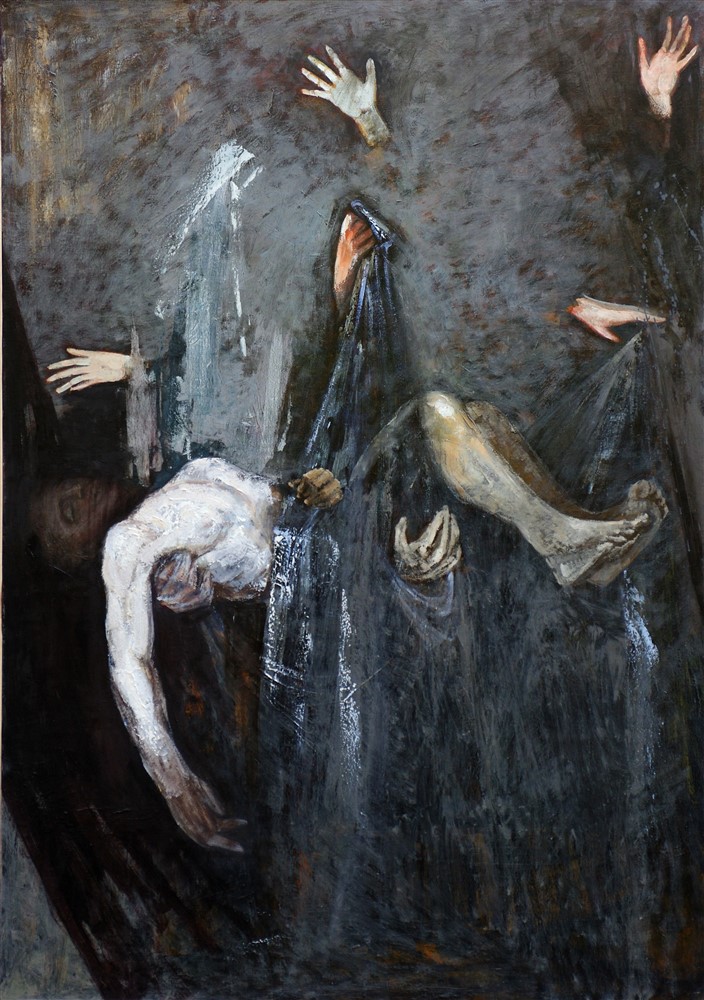Blog
On Art by Gayane Manasyan: about ways of seeing
Gayane Manasyan, also known by her artistic name – Ganna Frans, confirms her artistic intentions with several exhibitions already held and becomes the subject of discussion. In her works, she mainly conveys relations with the limits of the possibilities of artistic vision. The subject of this artist is painting in general and its history – past experiences, which are constantly revived with allusion to them, and different styles and achievements of specific artists create impressive, expressive images of individual works. Gayane Manasyan says that she is an artist-researcher, and among the merits of historical artists, she singles out the role of Caravaggio in particular, however, motifs of other artists also appear in her works (Goya, Corot, Böcklin) and these relationships determine the initial stage of inspiration, after which she continues to work with a high degree of freedom and reaches unpredictable results in her works with unexpected effects.
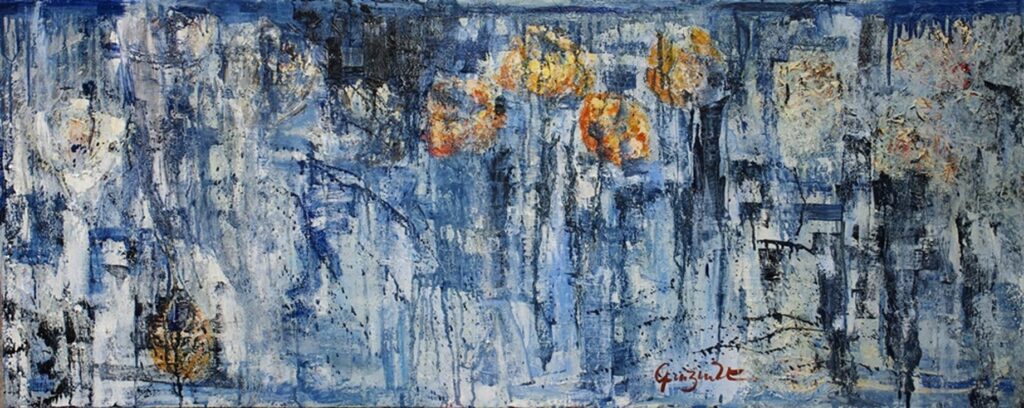
The Last Supper (oil on canvas,148X58 cm, 2015) is a vivid example of free interpretation, where the artist forgets the already legalized models of the iconographic system and at the same time preserves the importance of their factor. The canvas is almost abstract, with textural combinations of blue, white, and black at the surface and architectural associations, where fiery conditional “flowers” create a special drama. Recognizable forms, fragments of conventional Jerusalem, or the faces of the apostles can be seen in the texture and multi-layeredness. The perceiver is completely free to develop his own interpretations. Specific motifs and content references are secondary here, and the main thing is a living, vibrating image, where the generalization is large-scale and at the same time concise.
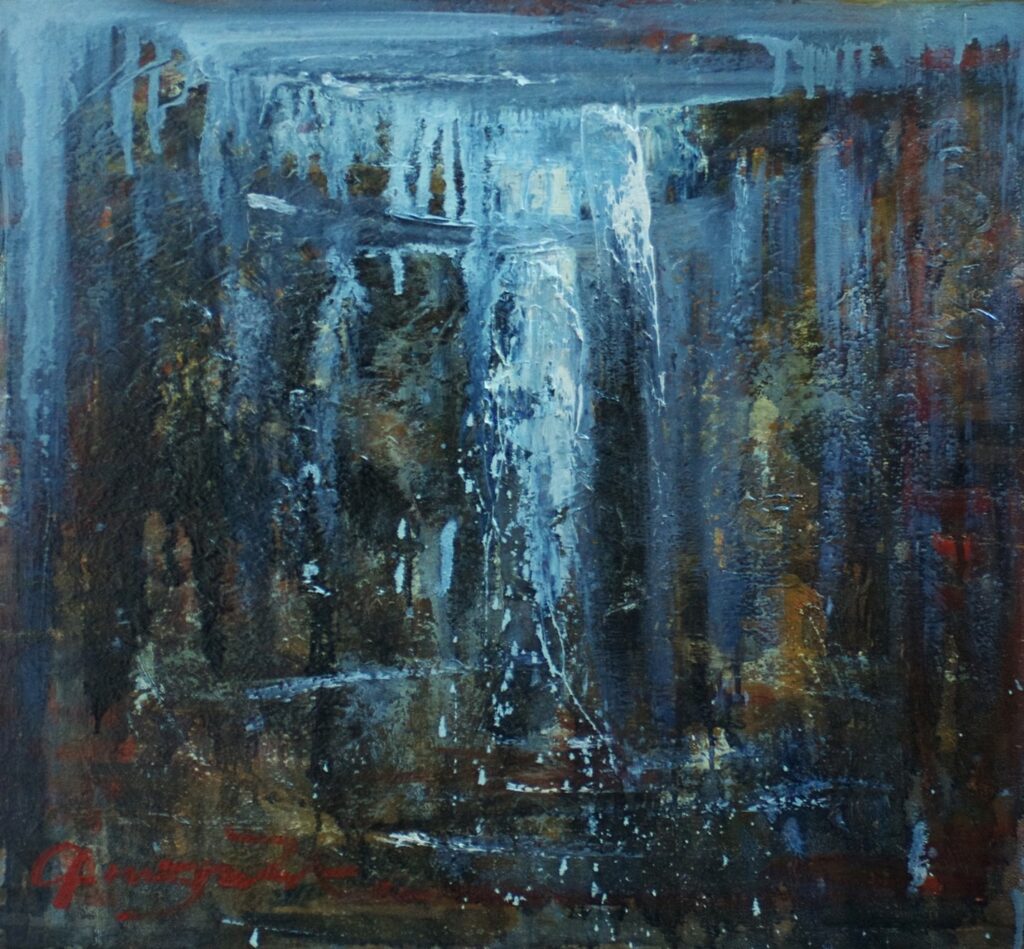
The Rainfall (oil on canvas, 80X60 cm, 2014) is also distinguished by its contradictory and multi-layered expressiveness. The work is based on the motif of abstract expressionism and creates a picture of spontaneously erupting energy. At the same time, it looks like a landscape of heavy rain seen from a window glass, and the center highlighted by a strong flow of water is perceived as a silhouette of the crucifixion. Accordingly, apocalyptic images also have a strong dramatic charge and fatal sadness.
The apocalyptic motif is even stronger in the picture of natural power – The Storm (oil on canvas, 60X 50 cm, 2013),
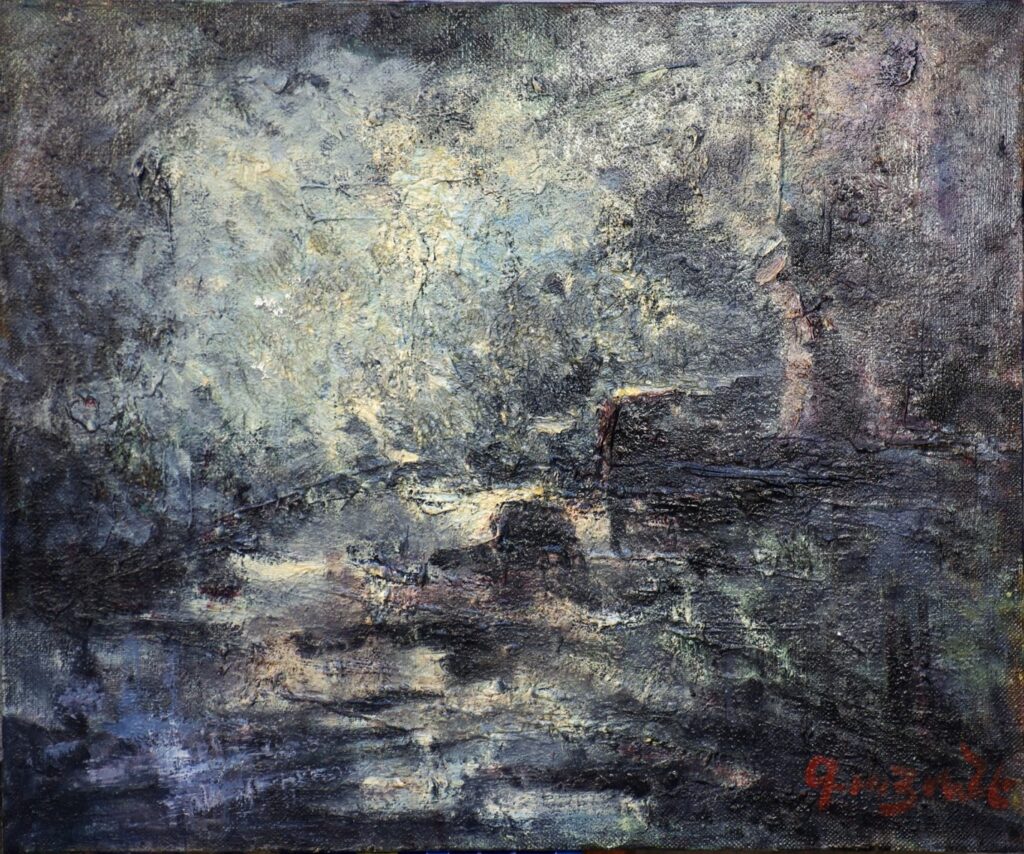
which aspires to abstraction and depicts a fragment of strong anxiety, the collision of dark blue and black masses with diagonally cut golden lights.
The image of the disaster conveyed by strong lines and free action is large-scale and creates the effect of a monumental canvas, notwithstanding the fact that the size of the work is not large.
One of the outstanding works of the mentioned motif is “Chaos” (oil on canvas, 98X84 cm, 2014),
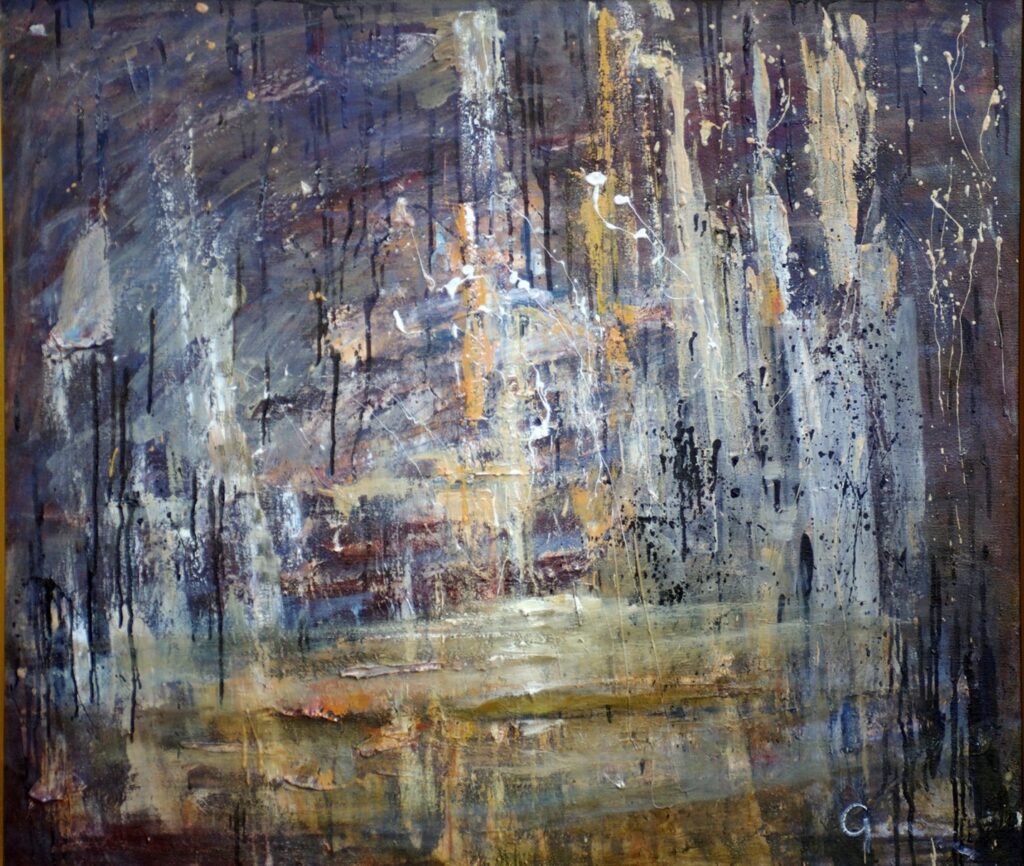
where the artist almost eliminates figurativeness and completely addresses the dimension of abstract expressionism. Here she is as free as possible and seems to visualize her unconscious with open, rough aggression. It is a kind of abstract landscape, with the desire to approach the transcendental field and at the same time, with great caution. In Gayane Manasyan’s painting, this caution is constantly shown.
Especially in emotional and expressive compositions, there is always an attempt to maintain balance, as if there is a feeling that the artist especially attaches great importance to the moment when she stops and considers the work completed. In addition, to the works built on the motifs of abstract expressionism, the interest in crossing abstraction with symbolism in Gayane Manasyan’s painting is no less important, and the character of this type of composition is more sensitive.
The spontaneous character of the emotions is replaced by the almost sentimental, symbolic allusions to the landscapes of gardens and architectural grounds. The Midnight Lotus (oil on canvas 50X60 cm, 2020)
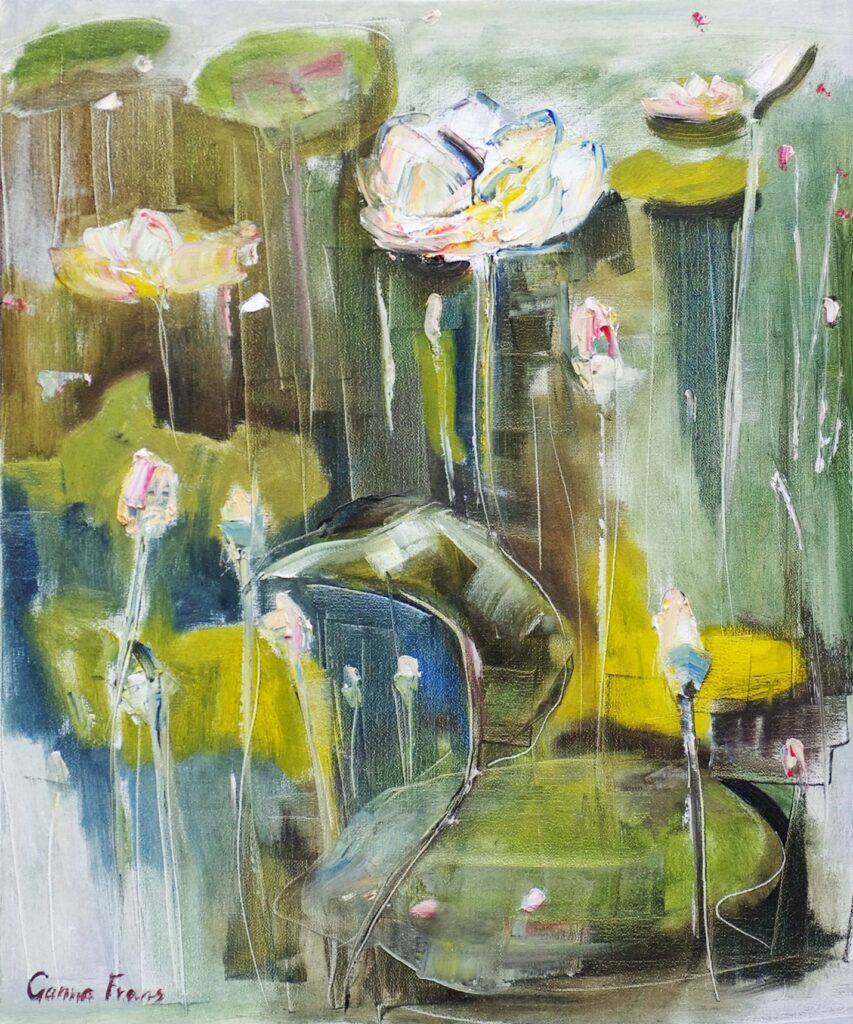
with its magic reminds us of the comments of Emil Nolde, where he says that flowers are mortal forms, mysterious creations of murky beauty that grow out of the soil, of such beauty that there seems to be both despair and an anxious obsession from the awareness of one’s own transience.
Flowers were the mortal forms that grow out of the womb of the earth, strange, mysterious creatures of fragile beauty–a beauty often enough desperate or feverish, as though aware of its own fugitiveness.“ Nolde, Emil u. Werner Haftmann. Emil Nolde. Harry N. Abrams. New York.1959]
Such examples of symbolist landscapes as The Theatre (oil on canvas, 25X50 cm,2022)

and The Tower (oil on canvas, 50X 60 cm, 2012)

are both romantic and gloomy at the same time, describing a complex emotion through a visual medium. The artist’s inspiration seems to rest on distant, vague associations and then develop entirely in imagination. Yellowish-green, foggy cloud-like surfaces hint at the mysterious contents, the mysteries that take place behind this conventional curtain. “Sunrise” (oil on canvas, 52.2X 58.7 cm, 2013)

also expands the theme of mysteries, although it is more intense, and sharp and again shows the character of pure abstraction. Here, the feeling of space is physically experienced, geometric shapes together with the changing wave of light convey the feeling of atmosphere, and a completely unexpected plant motif is a very original combination with a contrasting meeting of abstraction and decorative elements. In general, Gayane Manasyan created one of the most important projects of her painting with landscapes. The landscape is the basis of a personal, especially intimate experience for her, and the high degree of sensitivity always makes a great impression on the perceiver. With landscapes, she creates more of her own self-portrait and shares with the viewer how she experiences the world, what her vision is, and what her art can convey.
The thematic range of figurative works is as diverse and sometimes contradictory as that of abstract works. In Gayane Manasyan’s portfolio, after a seemingly banal still life, an extremely expressive and multi-layered, unexpected work can appear and raise questions. In some samples, the interest in anatomy, in the capabilities of the body can be seen, and in other places, the desire to visualize a hidden, complex feeling.
Gayane Manasyan tries to intensify the individual factor in all the portraits, but in the end, she still comes to a generalized, symbolic icon – sometimes she simplifies the form, and in some places, it resembles a supernatural, mythological character. Such, for example, is one of her clear, easy-to-remember works – “Owls” (oil on canvas, 53X76.5 cm, 2017),

which continues the tradition of symbolist painting and transforms an individual portrait into a semi-supernatural creature of a conditional pantheon. In the portrait gallery, there is great diversity in terms of style, and the dominant symbolist theme is periodically replaced by extremely expressionistic, distorted bodies, realistic academic graphics, apocalyptic destructive motifs, etc. (Joker Lady, The Parent, De-evolution, Thoughtful, Pieta, Metanoia).
The collection of works, in which Gayane Manasyan’s portfolio and history of her exhibitions are united, is an intriguing diverse material and does not allow to define the main features of her artistic vision briefly. This artist carries a large set of complex, diverse interests, from which periodically intense, original images are born. The artistic sensibility in these works is emphatically high and shows a consistent development of the vision, this artist can create completely different versions of landscape, portrait, and symbolic story and raise new expectations of the next development.
Dr. Khatuna Khabuliani
Art Critic and Curator
2023, August



